Are you considering using Adobe Commerce Cloud to launch and scale up your eCommerce store? If so, you have come to the right place. In this Adobe Commerce Cloud reviews, we’ll review all the crucial aspects of Adobe Commerce Cloud, including:
- An introduction to Adobe Commerce Cloud
- Pros and cons of Adobe Commerce Cloud
- Adobe Commerce Cloud pricing
- Ease of use
- Personalization for end-users
- Globalization features
- Multi-brand solution
- Mobile centricity with PWA
- Website performance
- Reports and analytics
- Security
- Support
Let’s dive right in!
An Overview Of Adobe Commerce Cloud
What is Adobe Commerce Cloud?
Adobe Commerce Cloud is a fully hosted, cloud-based version of the Magento platform. This package of Adobe offers you an integrated, end-to-end solution that combines the flexibility of Magento's open-source platform with advanced cloud capabilities.
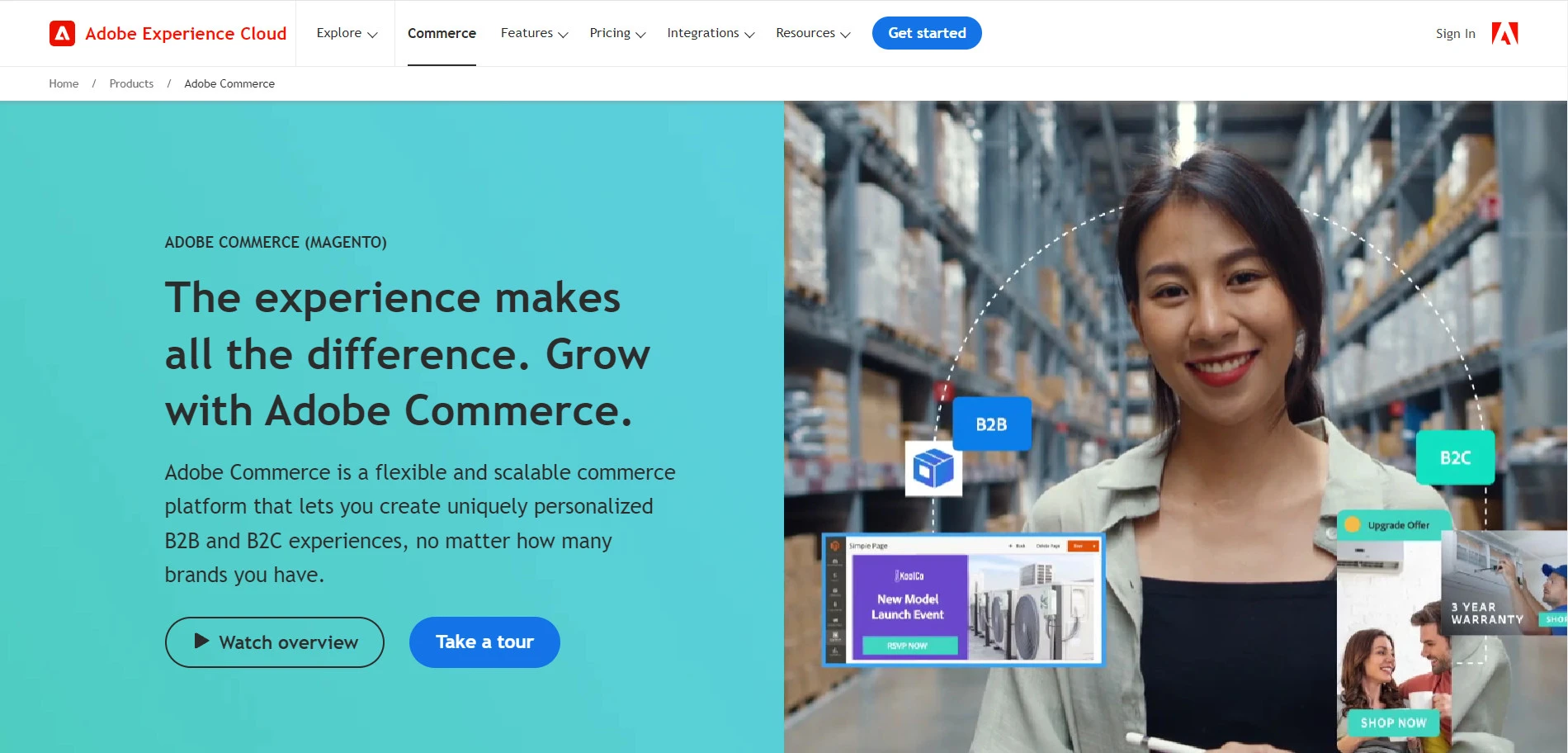
If you are a newbie who has done a bit of research, you might now be wondering: “Are Adobe Commerce Cloud and Magento Open Source the same?”
Short answer: They are not.
Adobe Commerce Cloud provides robust, out-of-the-box features, enhanced performance, scalability, enterprise-level functionality, and cloud infrastructure benefits like global availability, security, and scalability.
Meanwhile, Magento Open Source is a community version that allows you to download and install for free. Compared to Adobe Commerce Cloud, Magento Open Source doesn’t offer you as diverse and powerful features. Nevertheless, it’s a more affordable solution for small-to-medium-sized businesses.
Who is Adobe Commerce Cloud best for?
If you are an enterprise looking for robust B2B functionality, personalized marketing tools, and global cloud hosting, Adobe Commerce Cloud will make a perfect fit.
With Adobe Commerce Cloud, you can effortlessly handle high traffic volumes, complex catalogs, and global expansion without compromising on performance or security. We will discuss about it further in the following line of our Adobe Commerce Cloud reviews.
Adobe Commerce Cloud Reviews: Pros And Cons
Are you in a hurry? Let’s glance at all the pros and cons of Adobe Commerce Cloud compared with those of Magento Open Source and other platforms like Shopify, WooCommerce, etc.
Pros | Cons |
+ Optimized infrastructure for scalability, security, and performance without the need for in-house management. | - Can be pricey, especially for merchants on a tight budget. |
How Much Does Adobe Commerce Cloud Cost?
The first aspect we would discuss in this Adobe Commerce Cloud review is its pricing. All in all, Adobe Commerce Cloud consists of licensing fees and AWS-based managed hosting, which ranges from $40,000.00 to $190,000.00 per year based on your expected annual gross sales revenue.
Here’s an estimation:
Gross Sales Revenue | Adobe Commerce Cloud’s estimated cost (pre-discount) |
$0 - $1 million | $40,000 |
$1 - $5 million | $55,000 |
$5 - $10 million | $80,000 |
$10 - $25 million | $120,000 |
$25 - $50 million | $190,000 |
Adobe Commerce Cloud Reviews: All The Highlights
#1. Ease of use
Setting up Adobe Commerce Cloud might feel daunting at first, and you'll likely need some technical help to get everything running smoothly.
However, once you're past the initial setup, you can manage your online store within Adobe Commerce Cloud’s intuitive admin dashboard.
With that being said, the platform still comes with a steeper learning curve compared to several platforms like Shopify or Wix eCommerce. If you're aiming for advanced setups, be prepared to climb that curve.
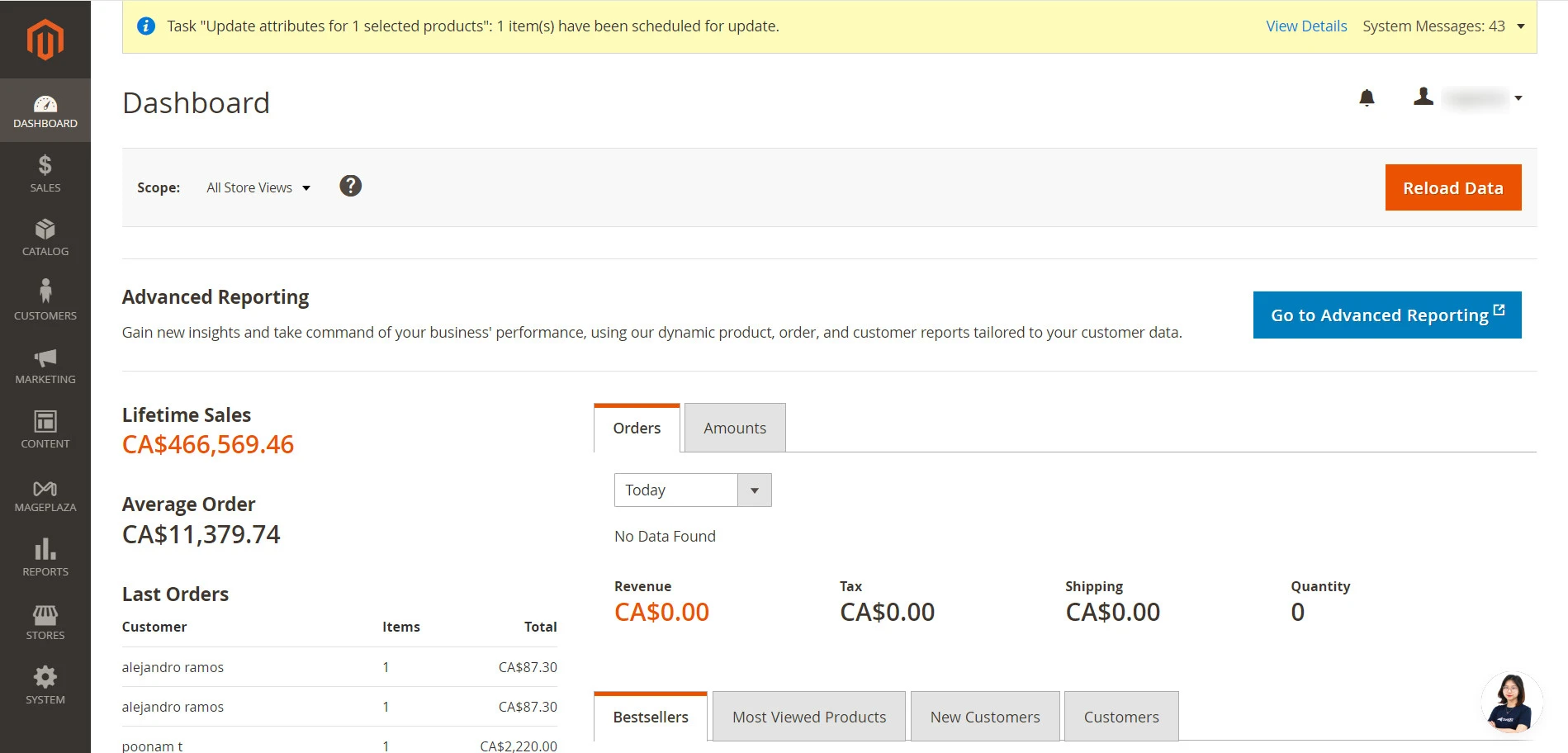
#2. Personalization for end-users
If you want to impress your potential customers by giving them a hyper-personalized on-site experience, Adobe Commerce Cloud won’t disappoint you. Adobe Commerce Cloud provides a suite of personalization features, enabling you to optimize your store for different target audiences:
- Customer segmentation: Create targeted content, promotions, and offers by segmenting customers based on their behavior, purchase history, and preferences.
- Dynamic content: Display dynamic content that changes based on customer segments or behaviors, providing a personalized browsing experience.
- Product recommendations: Utilize AI-driven tools to offer your customers personalized product suggestions based on their historical browsing and purchase data.
- Targeted promotions: Craft promotions and discounts targeted to specific customer segments, enhancing engagement and conversion rates.
- Content staging and preview: Preview and schedule personalized content and promotions to go live at specific times, ensuring relevance and timeliness.
#3. Globalization features
Globalization functionalities are one of the Adobe Commerce features we’d love to discuss in our Adobe Commerce Cloud reviews. This cloud-based platform offers extensive globalization features, allowing you to localize your store for different markets.
Here is a list of globalization features supported by Adobe Commerce Cloud:
- Multi-language support: Offers the ability to create and manage your website content in multiple languages, catering to a diverse customer base.
- Multi-currency pricing: Allows pricing and transactions in 90+ currencies, providing a localized shopping experience for international customers.
- Customizable geotargeting: Enables the customization of content, promotions, and product offerings based on the customer’s location, enhancing the relevance of the shopping experience.
- Localized payment methods: Supports a wide range of payment options popular in different regions, ensuring a smoother checkout process for global customers.
- Global shipping options: Adobe Commerce Cloud supports integrations with various major shipping carriers and services like UPS, DHL, USPS, FedEx, etc., enabling you to offer multiple shipping methods across different regions.
- Tax and VAT Handling: Automates the calculation of taxes and VAT for different countries, simplifying compliance and financial operations.
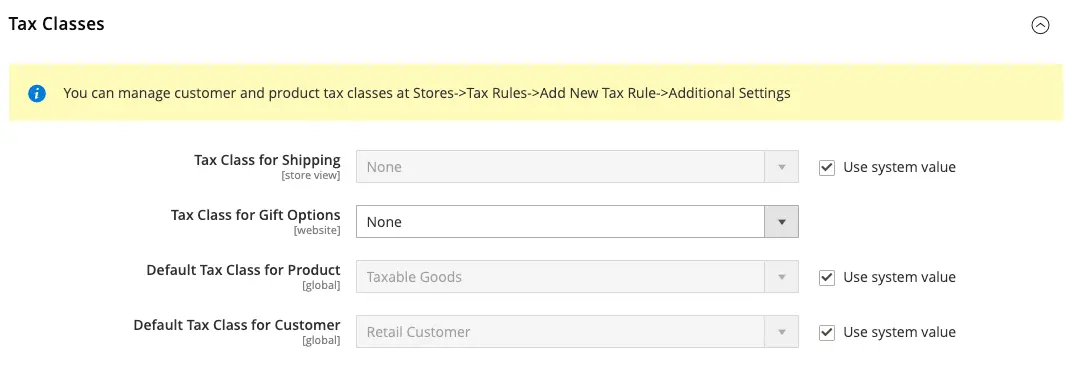
#4. Multi-brand solution
If you are an entrepreneur with dozens of brands, Adobe Commerce Cloud is nothing but a wise choice. Adobe Commerce Cloud empowers you to manage content, products, orders, etc., in one place, even if you have multiple brands, sell across various countries, or use different business models.
With Adobe Commerce, you can set up different prices, show specific products to certain groups of people, and tailor the checkout and delivery processes to meet your needs.
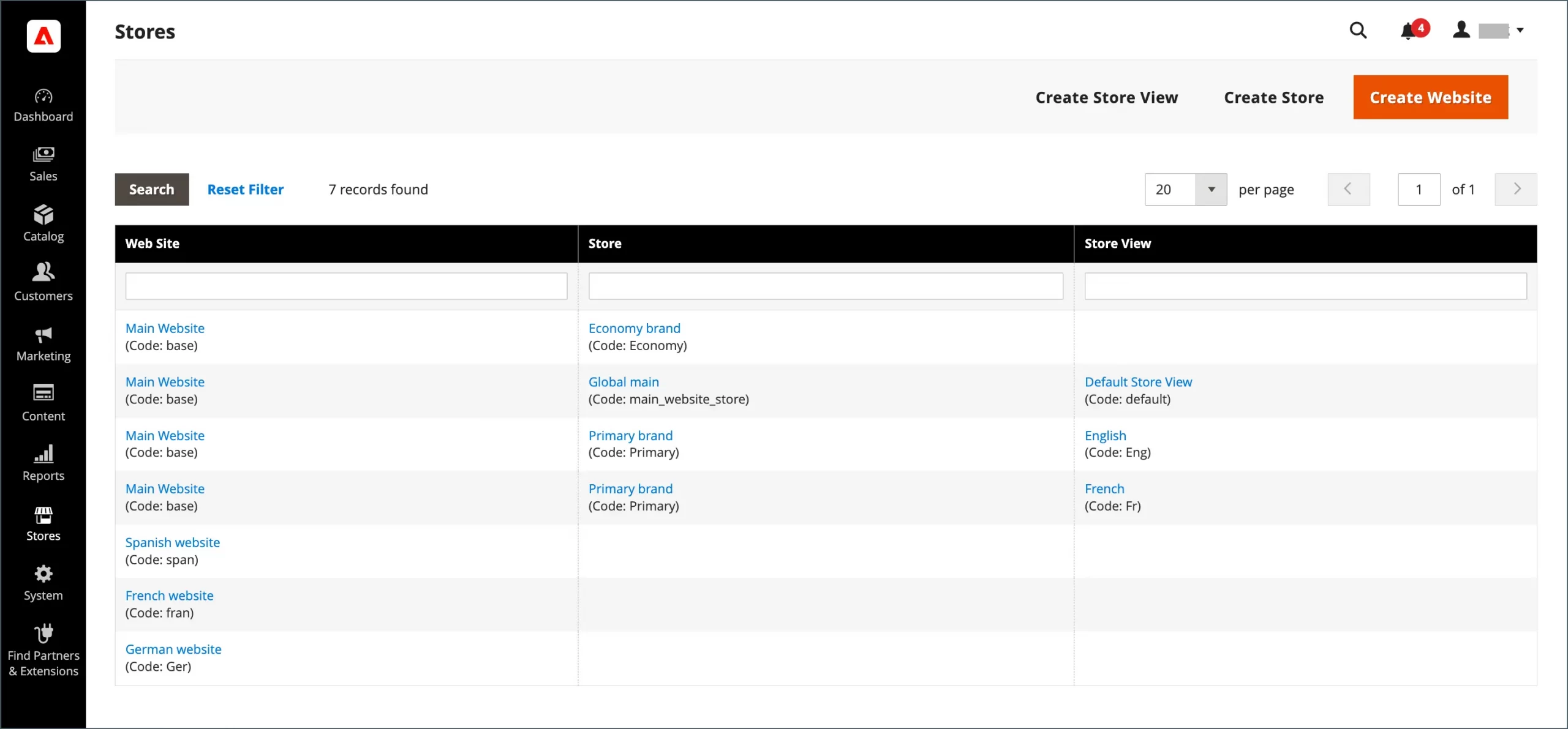
Adobe Commerce Cloud empowers you to:
- Manage multiple brands in a single interface, simplifying operations and analytics across all your eCommerce activities.
- Utilize shared catalogs across stores with brand-specific customizations, streamlining inventory management.
- Tailor the look, feel, and functionality of each brand site, allowing for unique brand identities within a unified platform.
- Process and fulfill orders from multiple brands in one centralized system, enhancing operational efficiency.
#5. Mobile centricity with PWA
With the ever-increasing trend to shop on smartphones, optimizing your web store for mobile devices is a must, not a plus. And this is where Adobe Commerce Cloud shines.
Adobe Commerce Cloud elevates mobile commerce by embracing Progressive Web Apps (PWAs), a technology that merges the best of web and mobile app features.
Launching a PWA with Adobe Commerce Cloud is streamlined, thanks to PWA Studio‘s developer tools and themeable reference storefronts.
Additionally, the combination of Adobe Commerce and PWA Studio offers significant savings on hosting costs. You won’t need separate Adobe Commerce hosting services for your storefront and backend, reducing overheads and simplifying the technology stack.
#6. Website performance
As page speed is one of Google’s official ranking factors, it’s a no-brainer to optimize your store for page speed. Hence, performance is the next thing we’ll examine in our Adobe Commerce Cloud reviews.
Adobe Commerce Cloud uses Fastly's Image Optimization (Fastly IO) technology for Cloud users. This means your images will be automatically adjusted to load your website faster, allowing your server to handle orders more smoothly.

Fastly IO works with popular image formats such as PNG, JPEG, and GIF and includes three main features:
- Force lossy conversion: This changes high-quality image formats like BMP, WEBP, PNG into smaller JPEG/WEBP formats, cutting down image size by 60% to 70% based on the Fastly IO settings.
- Deep image optimization: Specifically resizes images of products, but not images used in content management systems (CMS).
- Adaptive pixel ratios: By using a special “srcset” code for each product image, this lets you provide several sizes and resolutions of an image from just one source file.
#7. Report and analytics
If you want to optimize your costs and find areas for improvement, you have to stay on top of your store’s important metrics. Therefore, let’s talk about reports and analytics in our Adobe Commerce Cloud reviews.
Adobe Commerce Cloud gives you up to 100 pre-built reports that span multiple functions like marketing, sales, customers, etc.
The best part is that you can freely build your custom reports with custom sets of metrics using Adobe Commerce Cloud’s built-in SQL report-building editor.
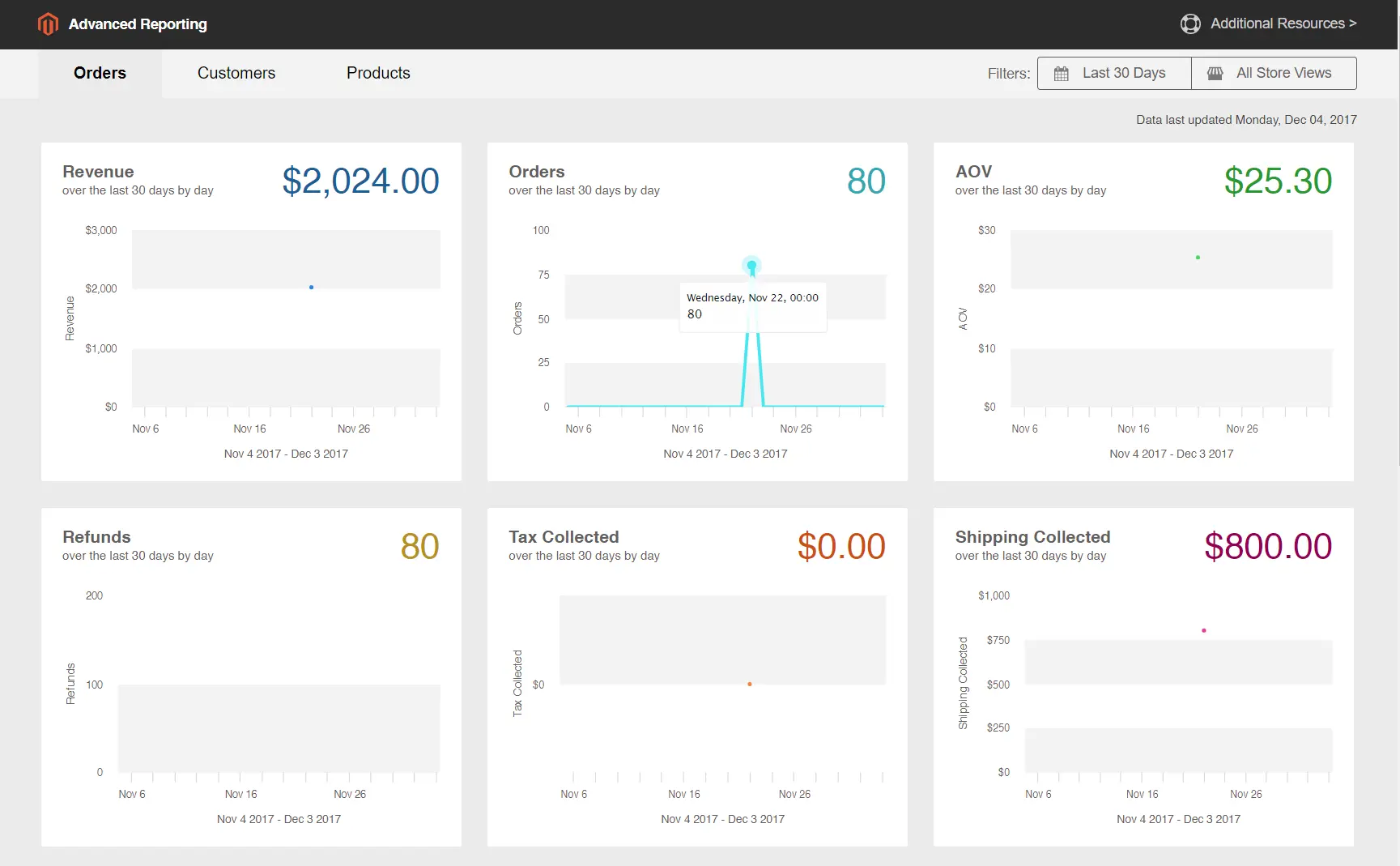
#8. Tightened security
Adobe Commerce Cloud takes your online store's security seriously, offering a robust set of features to protect your business and your customers' data:
- PCI DSS compliance: Out-of-the-box compliance with Payment Card Industry Data Security Standard (PCI DSS) ensures secure handling of sensitive payment information.
- Threat detection and prevention: Advanced intrusion detection and prevention systems (IDS/IPS) actively monitor and block malicious activity.
- Data encryption: AES-256 encryption safeguards sensitive data both at rest and in transit, preventing unauthorized access.
- Role-based access control: Granular access controls ensure that only authorized users can access specific data and functionalities.
- Regular security updates: Frequent security patches address vulnerabilities and protect your store against evolving threats.
- Two-factor authentication: Enhance login security with multi-factor authentication (MFA) for added protection.
#9. Support
Adobe Commerce Cloud is apparently not famous for its ease of use. Hence, having access to reliable support is crucial.
Unfortunately, we are not impressed by Adobe Commerce Cloud’s support by far.
You have access to tons of well-curated help docs and how-to tutorials. However, Adobe Commerce Cloud doesn’t yet provide live chat support or phone calls. Instead, you’ll have to submit support tickets via their support portal.
💡 So, is Adobe Commerce Cloud worth it? With hyper-personalization features, multi-store capabilities, lightning-fast page speed, and mobile centricity, Adobe Commerce Cloud is a dream come true.
If you are a big brand that wants to turn your online store into a sales magnet hub, Adobe’s cloud-based package is the way to go.
Nevertheless, if you’re fresh, Magento open-source and other eCommerce platforms like Shopify, WooCommerce, etc. would be of better money worth. Otherwise, you might operate at a loss, given Adobe Commerce Cloud’s pricey licensing fees.
Adobe Commerce Cloud Reviews: FAQs
Is Adobe Commerce any good?
Yes, Adobe Commerce (formerly Adobe Magento Commerce) is highly regarded for its flexibility, scalability, and extensive feature set, making it suitable for large-sized businesses looking to create customized, powerful eCommerce solutions.
How much does Adobe Commerce Cloud cost?
Expect to pay around $40,000 to $190,000 per year for Adobe Commerce Magento Cloud. For more accurate pricing, reach out to Adobe Commerce Staff for an exact quote.
What is the difference between Adobe Commerce and Commerce Cloud?
Adobe Commerce refers to the enterprise version of the Magento platform in which you select hosting from a third-party provider.
Adobe Commerce Cloud is essentially Adobe Commerce with added cloud hosting and services, providing an all-in-one cloud solution that includes hosting, security, and performance optimization.
What is Adobe Commerce Cloud?
Adobe Commerce Cloud is a cloud-based, managed eCommerce solution built on the Adobe Commerce platform. It combines the powerful features of Adobe Commerce with cloud infrastructure benefits, such as scalability, security, and enhanced performance.
Final Thoughts
Though pricey, Adobe Commerce Cloud is worth it if you are a growing store looking for a platform that offers you ultimate customization options and flexibility.
We hope after reading our Adobe Commerce Cloud reviews, you can make a more informed decision as to whether to use it or not.
Dive into LitExtension’s blog and check out our Facebook Community to get the latest eCommerce tips and tricks!

